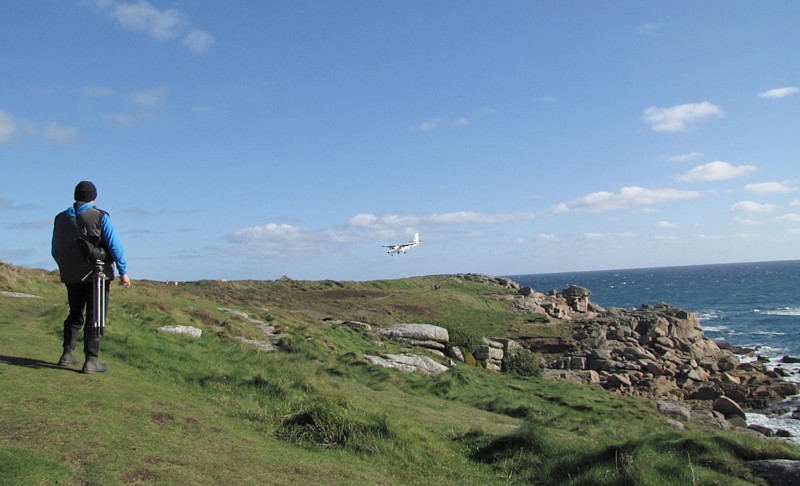On our first afternoon we walked from Hugh Town to Porthellick and back and only encountered around four other birders! I couldn't believe how quiet it was, not that I'm complaining. Even though rarities were rather thin on the ground I still managed to see three new birds, Barred Warbler on St Agnes and Olive-backed Pipit and American Buff-bellied Pipit on Bryher. Other nice birds seen were Richard's Pipit, several Red-breasted Flycatchers and Yellow-browed Warblers, Firecrest, 'Irish' Coal Tits, Ring Ouzels, Lapland Bunting, Snow Bunting, Spotted Crake, Black Redstarts (40+!) an interesting possible Ehrenberg's Redstart, Short-eared Owl, Whooper Swans, Ring-necked Ducks a Pale-bellied Brent Goose (woo!) and 41 Dark-bellied Brent Geese ( a record number for Scilly apparently).
There were a few birds around that we didn't see, but we only actually dipped one which was a Marsh Warbler on St Agnes. The only other low point was seeing a Swallow sp. in foggy conditions, for just a couple of seconds. It was definitely a Swallow and it had a pale rump, which means it was highly likely to be a Red-rumped Swallow, which would have been a lifer for me and a British tick for Bun. We just didn't see it well enough to be absolutely sure. Anyway, I'll show you some photos of some stuff, mainly birds, a few 'twitch' shots, a bit of scenery (although the weather wasn't any good for photography for five of the six days) and even a nice plant. But first....
Common Dolphin
St. Mary's
Whooper Swans. This was the first youngster I've ever seen.
Ring-necked Ducks.
These were the first females I've seen, they're more attractive than the male I reckon.
Stonechat.
Try as we might we couldn't see one that wasn't just a 'bog standard' one.
Snow Bunting on Porthloo beach.
Ring Ouzel.
Above Porthloo on the edge of the golf course. All the Ring Ouzels we saw were distant like this one, which was a shame.
St Agnes from the Woolpack Battery on The Garrison.
Black Redstart on The Garrison in the murk.
Although we saw over forty of these none would pose for a photo. They were very flighty compared to the overwintering ones I'm more used to.
I got distracted by this rock at Porthellick which I thought looks like a wallowing pig.
Also at Porthellick but a bit more interesting than a pig-shaped rock was this Redstart. It had come through on the pager as an Ehrenberg's Redstart. It does have a bit of a white patch on the wing but I wouldn't have thought it was anything other than a Common Redstart had I found it.
A few wader flight shots, courtesy of local dog-walkers, who can have their uses. Just a shame about the gloomy conditions.
This Spotted Crake was showing at very close range on a daily basis at Lower Moors. It was really difficult to photograph though as it was in a swampy patch in some trees which was very dark. This photo was taken with the lens wide open but this resulted in a slow shutter speed of 1/60 sec (way too slow for hand-held) and it's the only one that didn't come out blurry. Vegetation in the way was also a nuisance as you can see!
These two shots were taken at 1/500 sec and hence were underexposed.
I had to lighten them and they are rather grainy but at least I managed to get it without the vegetation in front.
St. Agnes.
The Yellow-browed Warbler/Red-breasted Flycatcher twitch at The Parsonage.
There were several of these at The Parsonage too. 'Irish' Coal Tit, identified by the yellow wash to the cheeks.
Red-breasted Flycatcher.
With my new camera it was the first time I'd had the opportunity to grab a shot of one of these, it's a shame the weather was gloomy/foggy. Awful light to have to work with.Still, I'm thrilled to have got a shot at all and the same can be said for this little beauty...
Yellow-Browed Warbler.
Barred Warbler.
Best bird of the trip for me, I've always wanted to see one of these and it's been a long time coming!
A bit blurry but I like this mid-air/invisible perch shot.
Bryher
This is the Olive-backed Pipit Twitch.
We got great scope views of the bird which was sneaking about on the ground amongst the weeds and flowers. Photos weren't possible though. There's a well known Scilly birder in this photo who was twitching the pipit as he needed it for his Bryher list apparently.
This is the Buff-bellied Pipit twitch.
The bird was nearer them than us but we had good enough scope views. It then flew out to a small island and we thought that would be our lot, but luckily a few minutes later it returned and landed on the rocks in the foreground, right below us!
This was just about all the birders on Bryher!
Buff-bellied Pipit.
It was that close below us that I mainly got shots of the top of its head!
The sun finally came out on our last day, but it was exceedingly windy and I didn't get many opportunities to photograph birds, so I took a couple of scenery shots.
Views from Giant's Castle towards Old Town and Peninnis Head
Self explanatory view.
Finally no blog post would be complete without...
A Butterfly.
This lovely new Small Copper is the latest one I've ever seen. It's also of the beautiful aberration caeruleopunctata. The only other butterflies seen were a few Red Admirals and Speckled Woods of the subspecies insula.
And a Flower.
This is Dark Mullein which was a new plant species for me. It is easily identified by the 'furry' purple anthers.

















































